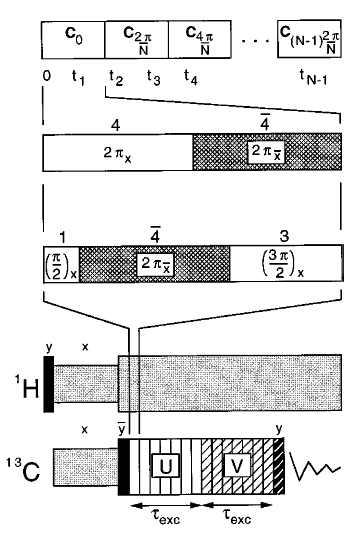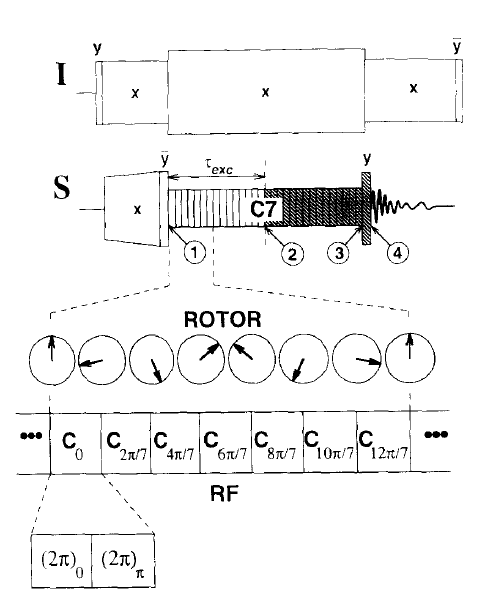
PC71d: 1D double quantum excitation POST_C7 pulse program for TopSpin2.1

Since non-phase cycling is applied to the PC7 excitation pulse, four-phase cycling is applied to the detection pulse P1 for selecting the 0Q -> -1Q coherence order jump, and four-phase cycling is applied to the PC7 reconversion pulse for filtering DQ coherences.
;pc71d (TopSpin 2.0) ;1D DQ excitation sequence POST_C7 ;for setup of the 2D INADEQUATE type experiments ;Hohwy, M. Jakobsen, H.J. Eden, M. Levitt, M.H., Nielsen, N.C., ;J. Chem. Phys. 108, 2686-2694 (1998) ;revised 09/09/03 JOS ;Avance II+ version ;parameters: ;d1 : recycle delay ;d20 : delay between saturation pulses ;pl1 : f1 power level for presaturation pulses and detection pulse ;pl7 : for POST C7 recoupling sequence, B1=7*cnst31 in Hz ;p1 : detection pulse at pl1 ;cnst31 : spinning speed, make sure cnst31>1000 ;l1 : number of composite C7 cycles for DQ excitation ;l20 : # of pulses in saturation pulse train, 0 if undesired ;ns : n*16 ;zgoptns :-Dpresat or blank ;$COMMENT=DQ excitation sequence post-C7 ;$CLASS=Solids ;$DIM=1D ;$TYPE=direct excitation ;$SUBTYPE=homonuclear correlation ;$OWNER=Bruker define pulse tau1 "tau1=((0.25s/cnst31)/7)" ; 90° pulse define pulse tau4 "tau4=((1s/cnst31)/7)" ;360° pulse define pulse tau3 "tau3=((0.75s/cnst31)/7)" ;270° pulse "d31=1s/cnst31" ;cnst11 : to adjust t=0 for acquisition, if digmod = baseopt "acqt0=1u*cnst11" #include <rot_prot.incl> #include <Avancesolids.incl> ze ;acquire into a cleared memory 1 d31 #ifdef presat ;set with -Dpresat pres, d20 ;delay between saturation pulses (p1 pl1 ph1):f1 ;saturation loop if required lo to pres times l20 #endif /* presat */ 2 d1 1m rpp11 ;reset the phase program ph11 pointer to the first element 1m rpp12 ;reset the phase program ph12 pointer to the first element 1m rpp13 ;reset the phase program ph13 pointer to the first element 1m rpp14 ;reset the phase program ph14 pointer to the first element 10u reset:f1 1u pl7:f1 3 tau1:f1 ph11 ipp13 ipp14 ;c7 excitation, 1 loop = 2*Tr/7, ;increment reconversion pulse phase ph13 and ph14 pointers ;to the next phase in the lists tau4:f1 ph12 ipp12 ;increment phase ph12 pointer tau3:f1 ph11 ipp11 ;increment phase ph11 pointer ;to the next phase in the lists lo to 3 times l1 3u 6 tau1:f1 ph13 ;c7 reconversion, 1 loop = 2*Tr/7, tau4:f1 ph14 ipp14 ;increment phase ph14 pointer tau3:f1 ph13 ipp13 ;increment phase ph13 pointer ;to the next phase in the lists lo to 6 times l1 p1:f1 ph5 pl1:f1 ;detection pulse 2u gosc ph31 ;gosc does not loop to 1 ;start ADC with ph31 signal routing ;DQ filtering (four phase cycling): 1m ip13 ;increments all phases of ph13 by 90° 1m ip14 ;increments all phases of ph14 by 90° ;1m ip13*16384 ;increments all phases of ph13 by 90° ;1m ip14*16384 ;increments all phases of ph14 by 90° lo to 1 times ns ;next scan 100m wr #0 ;save data HaltAcqu, 1m exit ph1= 0 ;for saturation pulse ph11 = (float,45.0) 0.00 51.43 102.86 154.29 205.71 257.14 308.57 ph12 = (float,45.0) 180.00 231.43 282.86 334.29 385.71 437.14 488.57 ph13 = (float,90.0) 0.00 51.43 102.86 154.29 205.71 257.14 308.57 ph14 = (float,90.0) 180.00 231.43 282.86 334.29 385.71 437.14 488.57 ;ph11=(65536) 0 9362 18725 28087 37449 46811 56174 ;ph12=(65536) 32768 42130 51493 60855 4681 14043 23406 ;ph13=(65536) 0 9362 18725 28087 37449 46811 56174 ;ph14=(65536) 32768 42130 51493 60855 4681 14043 23406 ph5= 0 0 0 0 2 2 2 2 1 1 1 1 3 3 3 3 ph31 = 0 2 0 2 2 0 2 0 1 3 1 3 3 1 3 1 ;ph31 = ph5 + 2*ph13

Definition of PC7 excitation pulse.

Definition of C7 excitation pulse.